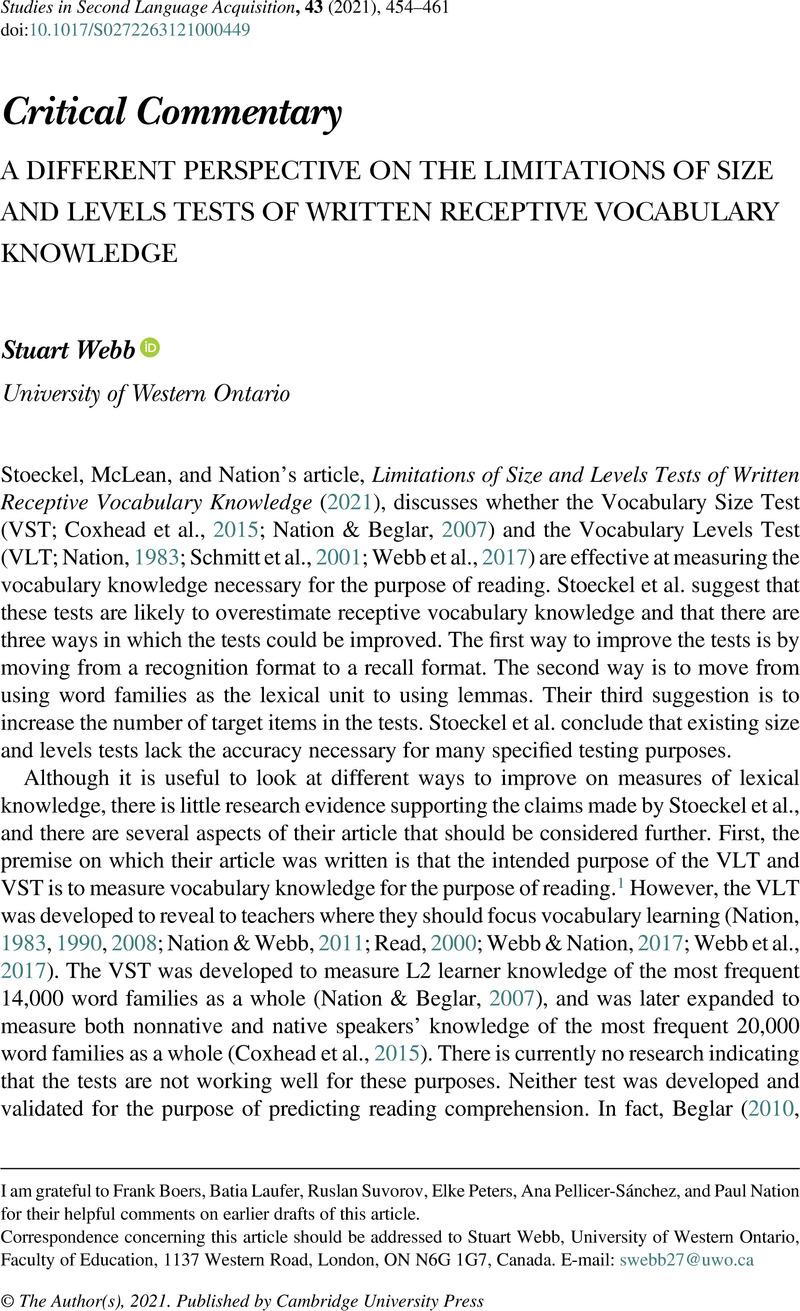Crossref Citations
This article has been cited by the following publications. This list is generated based on data provided by
Crossref.
Stewart, Jeffrey
Stoeckel, Tim
McLean, Stuart
Nation, Paul
and
Pinchbeck, Geoffrey G.
2021.
WHAT THE RESEARCH SHOWS ABOUT WRITTEN RECEPTIVE VOCABULARY TESTING.
Studies in Second Language Acquisition,
Vol. 43,
Issue. 2,
p.
462.
Webb, Stuart
2021.
WORD FAMILIES AND LEMMAS, NOT A REAL DILEMMA.
Studies in Second Language Acquisition,
Vol. 43,
Issue. 5,
p.
973.
Ha, Hung Tan
2022.
Test Format and Local Dependence of Items Revisited: A Case of Two Vocabulary Levels Tests.
Frontiers in Psychology,
Vol. 12,
Issue. ,
Ha, Hung Tan
2022.
Issues in matching learners to their reading levels using receptive vocabulary knowledge – A closer look at the vocabulary levels tests and scoring methods.
Heliyon,
Vol. 8,
Issue. 8,
p.
e10244.
Stoeckel, Tim
Ishii, Tomoko
Kim, Young Ae
Ha, Hung Tan
Ho, Nam Thi Phuong
and
McLean, Stuart
2023.
A comparison of contextualized and non-contextualized meaning-recall vocabulary test formats.
Research Methods in Applied Linguistics,
Vol. 2,
Issue. 3,
p.
100075.
Ncanywa, Thobeka
2023.
Eurocentric, Westernized, or Afrocentric curriculum in one university in the Eastern Cape: An entrepreneurship approach.
International Journal of Research in Business and Social Science (2147- 4478),
Vol. 12,
Issue. 10,
p.
113.
Read, John
2023.
Towards a new sophistication in vocabulary assessment.
Language Testing,
Vol. 40,
Issue. 1,
p.
40.
Finlayson, Natalie
Marsden, Emma
and
Anthony, Laurence
2023.
Introducing MultilingProfiler: An adaptable tool for analysing the vocabulary in French, German, and Spanish texts.
System,
Vol. 118,
Issue. ,
p.
103122.
Komiya, Chihiro
and
McLean, Stuart
2024.
Which Type of Vocabulary-Knowledge Better Correlates with Reading-Comprehension, Meaning-Recognition or Meaning-Recall?.
RELC Journal,
Zhang, Haiwei
Sun, Peng
Bianglae, Yaowaluk
and
Widiawati, Winda
2024.
The development of a Chinese vocabulary proficiency test (CVPT) for learners of Chinese as a second/foreign language .
Language Testing,
Vol. 41,
Issue. 2,
p.
412.






